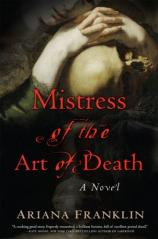Mistress of the Art of Death
Review
Mistress of the Art of Death
The year: 1171. The place: England, or, more specifically, the road
between Canterbury and Cambridge, as a party of pilgrims travels
home from visiting the newly sainted (and recently murdered) Thomas
a Becket's shrine. The setting for Chaucer's Canterbury Tales?
Perhaps. But it's also the backdrop for the opening of Ariana
Franklin's superb new thriller, MISTRESS OF THE ART OF DEATH.
If you've read Chaucer's tales, you know that pilgrims weren't
necessarily the pious types you might expect. Far from it, in fact.
And so it is among Franklin's pilgrims, although in this case, the
extent of the impiety goes far deeper. For among the assembled
pilgrims is a truly monstrous killer, a murderer of children.
Also among the company, riding humbly in a cart, are a Jewish
detective, a Muslim eunuch bodyguard and a doctor. This may sound
like the set-up for a joke, but the work of these three companions
is deadly serious. They come from Italy at the order of the King of
England, Henry II, in order to investigate a series of child
murders in Cambridge, which the locals are blaming on the town's
Jews. Henry has his own reasons for wanting the Jews exonerated,
and so he has sent to Italy for their best "Master of the Art of
Death," a specialized doctor who can "read corpses." Something like
today's forensic scientists, these specialists, trained at the
medical school in liberal Salerno, can find clues as to how --- and
sometimes by whose hand --- victims were killed.
What Henry doesn't know, however, is that the "master" in this case
is actually a "mistress," a young woman named Vesuvia Adelia Rachel
Ortese Aguilar, an accomplished doctor and the most celebrated
post-mortem analyst in Salerno. No wonder she has been sent on this
dark mission, accompanying Simon of Naples, a Jewish investigator,
to determine the cause of death of four children. Before her work
in Cambridge is done, though, Adelia will become far more
intimately involved with the case than she had ever dared to
imagine. During her stay in Cambridge, she will lose a dear friend
and gain the love of her life --- sort of.
Although MISTRESS OF THE ART OF DEATH is the first thriller
featuring Adelia, its author is far from a novice; Ariana Franklin
is the pen name of British author Diana Norman, a former
journalist, biographer and historical novelist. Franklin also
happens to be a dedicated medieval history buff, and it shows. This
thriller, in addition to being skillfully plotted, is also
meticulously researched, giving readers bold new insights into
cultural practices, political intrigues and medical knowledge of
the day.
Readers, for example, may be surprised to learn that a female
doctor such as Adelia is a completely conceivable historical
character --- at least in Italy. Adelia, raised by a pair of
doctors and surrounded by compassionate people of all faiths, is
shocked and horrified by the ignorance, prejudice and
small-mindedness she encounters in England.
Here she could be executed as a witch for practicing medicine; here
the Jews, even the wealthy ones, are ghettoized and hanged or
marched off to prison en masse at the first sign of trouble.
Franklin's depiction of Adelia's cross-cultural friendships, as
well as her discussion of the recent Crusades and their
long-lasting effect on Christian-Islamic relations, seems intended
not only to shed light on history but also to point a finger at
more current political issues.
This is not to say, though, that MISTRESS OF THE ART OF DEATH is a
dry historical tome. Far from it. In addition to bringing history
vividly alive, Franklin crafts a top-notch plot, with twists that
will continue to surprise readers to the very last page. Gory
enough to gratify any Patricia Cornwell fan, detailed enough to
satisfy medievalists and filled with a dozen or more well-realized
supporting characters, Franklin's accomplished thriller crafts a
12th-century world that 21st-century readers will be eager to
inhabit again.
Reviewed by Norah Piehl on January 7, 2011




